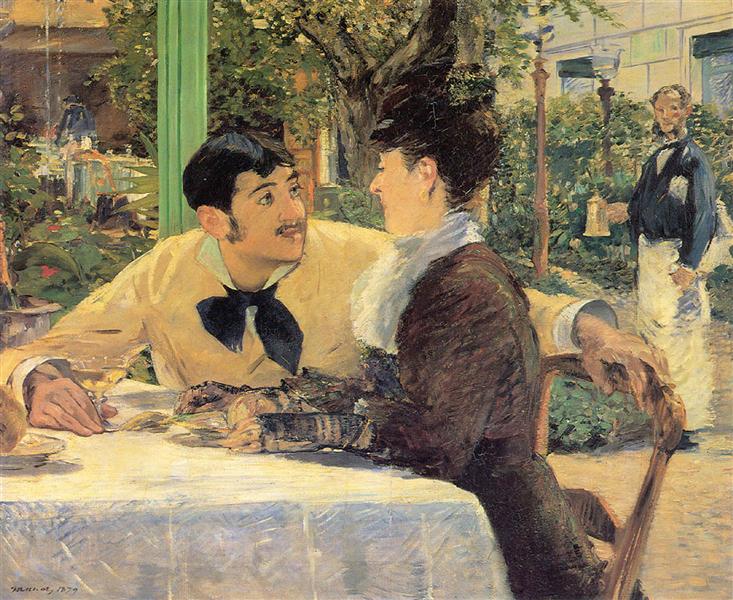Description
In Édouard Manet's At the House of Father Lathuille (1879), both the significance of his impetuous style and his mastery in depicting the daily life of the 19th-century Parisian bourgeoisie are evident. This painting, in which Manet captures a scene in a restaurant, is notable for its profound sense of color, the arrangement of the characters, and its evocative use of light. The composition reflects Manet's ability to capture fleeting moments with an immediacy that transcends mere representation.
The work depicts a group of figures seated around a table, in what appears to be a celebration or social gathering. The most prominent figure, a man in a top hat, is at the centre of the painting, addressing the others with a gesture that may suggest animation or discussion. Flanking him, two elegantly dressed women are depicted in conversation, giving the scene a sophisticated yet casual air. Beside them, another man can be seen, with a more introspective expression, who seems to reflect on the conversation or perhaps contemplate the surroundings.
The contrast of colours in this work is remarkable. Manet uses a rich palette, composed of warm and earthy tones that evoke a cosy and intimate atmosphere. Shadows and lights play a crucial role, creating depth and volume in the composition. The way the light spreads over the surfaces of the table and the bodies of the characters brings the scene to life, almost as if the viewer can hear the laughter and murmurs emanating from the conversation.
The restaurant setting, though only a suggested background, serves to contextualize the characters. The dark walls, the sober decor, and the arrangement of objects on the table, such as the bottle of wine, establish a refined atmosphere. Manet, an innovator of his time, imbues the scene with a sense of realism that challenges academic conventions. Rather than idealizing his figures, he presents them with flaws and peculiarities that echo the human condition, a recurring theme in his work.
Manet's works, including this intimate scene, have often been interpreted as applications of a break with the painting tradition of academicism. His impressionist style, clear in its loose brushstrokes and capture of light, aligns him with other artists of his time who sought a more direct approach to visual perception. This painting, in particular, can be compared to other works that reflect the social and cultural life of the era, such as Manet's "Breakfast on the Grass" or "Luncheon on the Grass," which challenged established norms and sought to portray contemporary reality.
When viewing “At the House of Father Lathuille,” the viewer is invited to become an unseen participant in a moment of everyday life, where social interaction comes to life through subtle details and a vibrant palette. The work, in addition to being a testament to Manet’s talent, becomes a reflection of a time when social norms were beginning to transform, and his style remains a primary influence on the development of modern painting.
KUADROS ©, a famous painting on your wall.
Hand-made oil painting reproductions, with the quality of professional artists and the distinctive seal of KUADROS ©.
Painting reproduction service with satisfaction guarantee. If you are not completely satisfied with the replica of your painting, we will refund 100% of your money.

